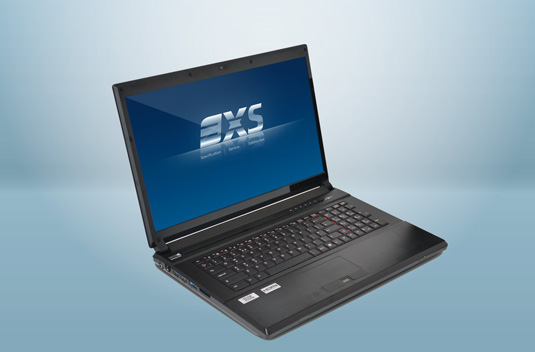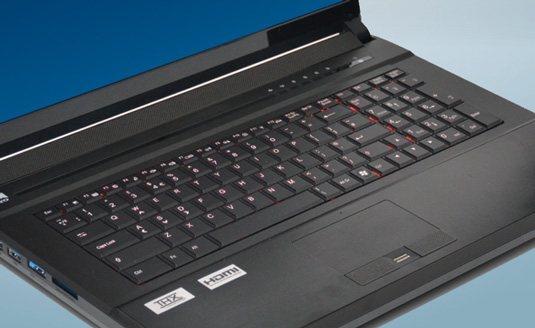Why you can trust Creative Bloq

You don't expect to get desktop workstation-levels of performance in a portable format, but these days you can get pretty close. Scan's 3XS MGW-20 is a case in point. At almost 4kg, it's not exactly light – but you can still carry it easily between locations and even use it on the move, despite the fact that its graphics performance is close to that of the fastest desktop systems.
The key feature here is the Nvidia Quadro K5000M graphics card, which sports a whopping 1,344 CUDA cores and 4GB of GDDR5 memory - not far off the desktop Quadro K5000. The memory bandwidth of 96GB/sec is a little further behind, but on the plus side this is a 100W GPU, which is still a lot for a laptop but considerably less than more powerful desktop accelerators. While there's an even more powerful Quadro K5100M just around the corner, this will require a platform update to Intel's latest Haswell generation of CPUs.
The MGW-20 actually uses the same Intel Ivy Bridge processor as the last Scan notebook we reviewed, the MGW-10 (3D World issue 169) - an Intel Core i7 3740QM, which is a quad-core processor rated at 2.7GHz. However, Intel Hyper-Threading will enhance parallel tasks such as 3D rendering, and Turbo Boost can increase a single core to 3.7GHz. The processor is partnered with a very healthy 32GB of 1,600MHz DDR3 SDRAM; more than enough for even high-end 3D apps.
The storage provisions are similarly high- end, although not a significant advance on the MGW-10. The main operating system and applications are stored on a 256GB Samsung 840 Pro SSD for super-fast access, while a 750GB Western Digital Scorpio Black 7,200rpm hard disk takes care of more general storage.
There's also a combination Blu-ray and DVD rewriter, as well as the usual SD card reader, four USB 3.0 connections and even a combined eSATA and USB port. The 17.3in display is also bright and clear, with a 1,920 x 1,080 resolution. It isn't on a par with the IPS panel available with the Dell Precision M6700 (issue 168), but it's still very capable.

Packing a punch
Not surprisingly, the MGW-20 shows unquestionable prowess in our modelling performance tests. Its score of 77.16 in the OpenGL portion of Maxon Cinebench R11.5 is one of the highest we have seen from any workstation. Similarly, its abilities are showcased with SPECviewperf 11; the result of 75.12 in the lightwave-01 test is towards the top of all the systems we have reviewed, as is the score of 103.6 in Maya-03. With 62.75 in the sw-02 SolidWorks viewset, this notebook will be superb for product design as well.
However, while its rendering abilities are clearly of desktop grade, the result of 5.91 in the CPU portion of Maxon Cinebench R11.5 is behind Scan’s own 3XS MGW-10. It also only lasted 78 minutes on battery when running our OpenGL preview test though, so you won’t be able to do much work away from the power socket.
The Scan 3XS MGW-20 is undeniably powerful - in fact, it is the gruntiest notebook we have ever seen for modelling and 3D content creation. It is worth noting that a desktop workstation with this level of performance, such as Scan's own 3XS GW-HT10, would set you back quite a bit less. But if you need this level of modelling power in a portable format, Scan undercuts Dell's alternative by a significant amount, ensuring it a healthy future.
Verdict
Scan 3XS MGW-20
Score: 8/10
This notebook shows how far mobile graphics have come, with its Nvidia Quadro K5000M providing some of the fastest performance we have seen.
Uppers
- Desktop-grade modelling
- Good rendering performance
- Decent value
Downers
- More expensive than comparable desktops
- Heavy for a notebook
James Morris has tracked the rise of every new development, from OpenGL accelerators to multiprocessor workstations, over 15 years of testing 3D content-creation hardware.
This article originally appeared in 3D World issue 175 - on sale now!

Thank you for reading 5 articles this month* Join now for unlimited access
Enjoy your first month for just £1 / $1 / €1
*Read 5 free articles per month without a subscription

Join now for unlimited access
Try first month for just £1 / $1 / €1

The Creative Bloq team is made up of a group of art and design enthusiasts, and has changed and evolved since Creative Bloq began back in 2012. The current website team consists of eight full-time members of staff: Editor Georgia Coggan, Deputy Editor Rosie Hilder, Ecommerce Editor Beren Neale, Senior News Editor Daniel Piper, Editor, Digital Art and 3D Ian Dean, Tech Reviews Editor Erlingur Einarsson, Ecommerce Writer Beth Nicholls and Staff Writer Natalie Fear, as well as a roster of freelancers from around the world. The ImagineFX magazine team also pitch in, ensuring that content from leading digital art publication ImagineFX is represented on Creative Bloq.
